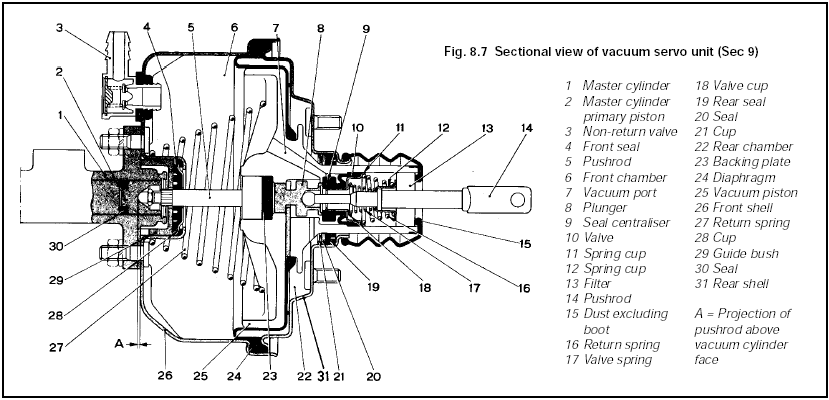 Checking and replacing the servo
Checking and replacing the servo
The task of the servo is to support the force of pressure on the pedal during braking of the vehicle. A servo malfunction does not mean a reduction in braking performance, but the need to increase the force on the brake pedal.
The servo operation is checked by performing the following steps.
■ Briefly start the engine.
■ With the engine off, depress the brake pedal. You should hear a soft hiss when you release the pedal.
■ Repeat this operation 5…10 times. The pedal must become hard afterwards.
■ Keep the pedal depressed and start the engine. The pedal should slightly lower under pressure from the foot.
■ Meeting the above conditions means, that the servo is operational.
■ If you notice no change or no hissing sound when you press the pedal, it means that there is no negative pressure at the entrance to the servo. You should then take into account:
- damage to the inlet check valve, servo leakage,
- leakage in the conduit connecting the servo with the intake manifold,
- damage to the vacuum pump (compression ignition engine).
■ If the servo only works while driving, the check valve is faulty.
■ You cannot repair a damaged servo yourself. The non-return valve is easy to replace (is depressed).
The servo is replaced by the following steps.
■ Remove the master cylinder.
■ On the driver's side, remove the nut retainer at the brake pedal, unscrew the nut and remove the pin from the servo valve control spindle.
■ Unscrew the nuts securing the servo to the front of the body and remove the servo.
The servo assembly is performed in the reverse order. Replace the nut lock on the brake pedal. Clearance between the pusher and rear pump piston (2) should be 0.825…1,025 mm. Perform the measurement with a caliper. The clearance is adjusted with a screw screwed into the pusher {5). If the brake hoses were unscrewed from the pump, the system must be deaerated after the assembly is completed.